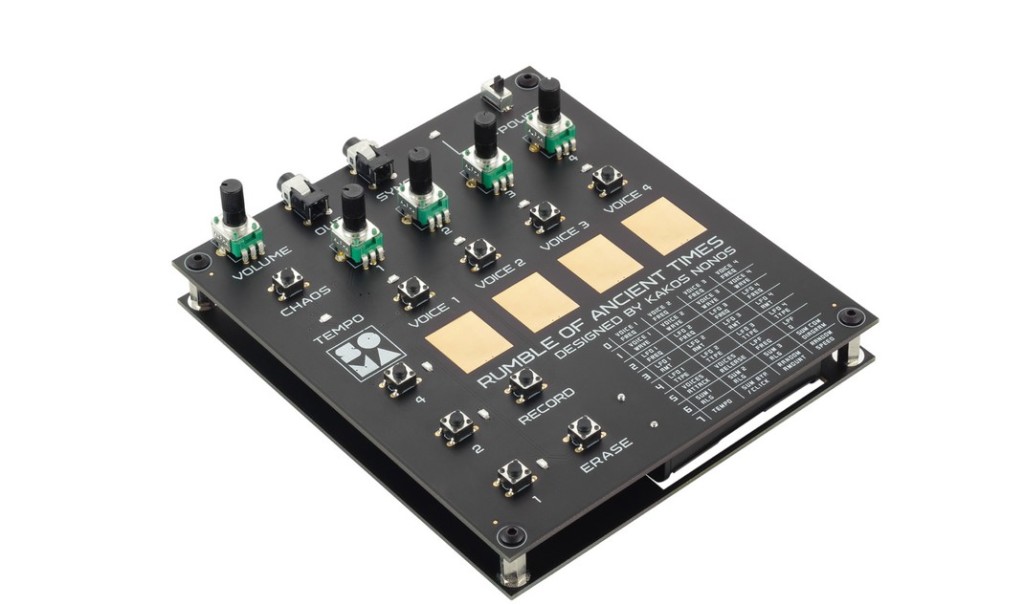The romantic engineering synth maker has something small and affordable, a post-apocalyptic weirdo instrument from designer Kakos Nonos. It’s part chip music, part noise experiment, in the grand tradition of stuff like the Atari Punk Console. Meet Rumble of Ancient Times aka Грохот древних эпох.
It’s great to see Soma using some of their recent notoriety to act as a label for other makers – and the timing is right, as we all scramble to deal with the suddenly upside-down world of parts availability to figure what you can even make. So Kakos’ creations have found their way before if you knew where to look – and I love the original wooden case. Here’s that one-off incarnation from the artist/inventor, aka Alexandr Zavgorodny, circa 2019:
And here’s the new edition from SOMA, featuring video FX and music from Kakos Nonos plus pixel art by John Normon Irr.:
Now the mayhem can be yours, just in time to celebrate … uh whatever is happening on planet Earth in January-February 2022 when this ships. 130€ buys you a compact pre-assembled instrument.
Here’s how it works:

You have four sound oscillators, each both with a tunable waveform and a dedicated LFO for each. Each can be toggled on and off via the panel or the sequencer, and they can be summed in one of three ways – here’s a picture from the manual:

That summing is where things get very odd, especially as each has its own summing algorithm. Think digital glitchy mayhem, basically, which you can also sequence.
Then you go through a resonant filter, which also sounds… very aggressive, let’s say.
To shape that architecture, you have 8 pages x 4 registers, so 32 parameters to tweak, including that summation type per-node. Each oscillator has 16 wavetables to choose from, and you can set different LFO modulations to one of eight types.
All the sound mangling then comes from messing with those LFOs, and then there’s this:
Meanwhile, the values of all pots will be connected. Let’s say, the clock is set to 2 Hz. By using the multipliers, it is possible to get LFO frequencies of 2, 4, 8, 16 Hz. As a result, the LFOs are connected and it is possible to get interesting rhythmic effects.

So in case this isn’t already clear, it’s a fairly radical idea – make a hands-on synth that gives you low-level LFO and clock control of digital synthesis the way vintage chip scores for video games did. Plenty of trackers might do that, but not so often tweakable synths – or if so, not with this many playable parameters.
The algorithms are clever, too – different addition, subtraction, multiplication, exclusive or (XOR), FM, and waveform modulation options.
If you didn’t already to the math on this, SOMA did it for you – 1,536 different summing variations.

What do you get? Well, for many – a headache. For people who love these kinds of sounds, though, a lot of joy.
It also supports incoming and outgoing clock signals, so you can use it with other compact stuff like Teenage Engineering’s Pocket Operators or KORG’s volca line. And that means you could fit some gnarly digital sounds into another context so it isn’t only weird noise solo. (5V sync out; 0.2V minimum sync in)
It all runs on 4xAAA batteries and weighs just 145 g (about 5 oz).
SOMA also have a manifesto behind their thinking here, though – whatever industry leaders they mean, I’m sure they won’t get any argument from us on this!
In stark contrast to modern consumer electronics, this synth celebrates and emphasizes what can be achieved with efficiency of code and using chips considered obsolete by industry leaders. We live in an age where text editors can be 1GB or more and simple things like checking email require the latest OS and powerful processing, despite the core tasks being no different than 15 years ago with a fraction of the computational power.
So RoAT proposes a new kind of ecological thinking with the innovative use of chips that were developed and produced decades ago, instead of turning them into millions of tons of trash. We can still use technology that the industry forced us to consider obsolete, with the added benefit here of extremely low power consumption. It’s an environmentally friendlier approach than galloping in the rush of planned obsolescence that damages our planet and wastes precious resources.